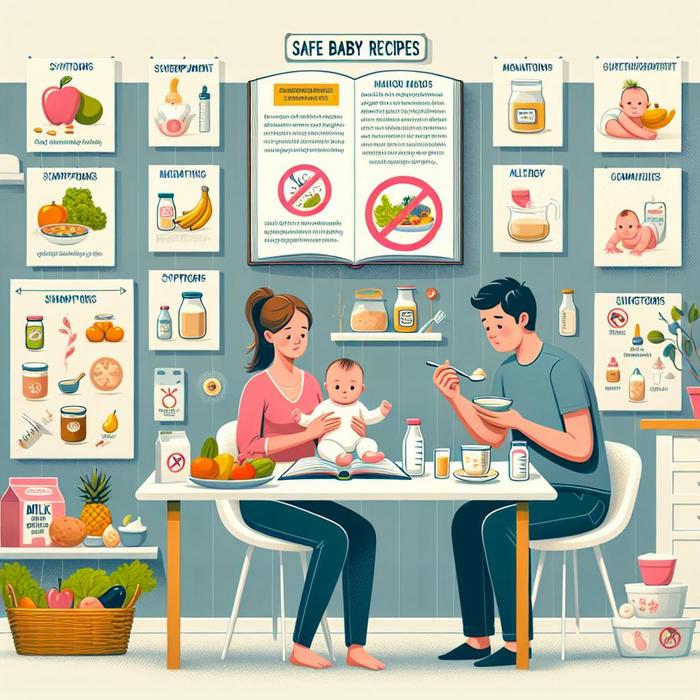Understanding Baby Food Allergies: The Basics
Before diving into safe recipes and baby food allergy tips, it’s crucial to understand what constitutes a food allergy in babies. A food allergy occurs when the baby’s immune system mistakenly identifies the proteins in food as harmful. The body, in response, launches a defensive attack, resulting in allergy symptoms.
Recognizing Symptoms of Food Allergies
Spotting the signs of a food allergy can be a daunting task. However, understanding your baby’s reactions to different foods can help manage symptoms more effectively. Some common symptoms include:
- Skin reactions such as hives or eczema
- Difficulty in breathing
- Abdominal pain or diarrhea
- Vomiting
- Swelling around the mouth or face
It’s important to remember that symptoms can range from mild to severe and can appear within minutes or several hours after food consumption. If you believe your baby has a food allergy, it’s imperative to seek the advice of a healthcare professional.
Managing Symptoms and Ensuring Safety
The first step in managing symptoms is identifying the food causing the reaction. An elimination diet, under the guidance of a healthcare professional, can help determine the problematic food.
Once identified, it’s essential to avoid the allergenic food to prevent discomfort; this is where safe recipes come into play. Safe recipes are those that replace common allergenic foods with allergy-friendly alternatives.
For instance, if your baby is allergic to cow’s milk, you can opt for recipes that use plant-based milk instead. It’s also recommended to introduce new foods to your baby one at a time. This method allows parents to pin-point any allergy triggers more effectively.
Having a baby with food allergies may feel limiting at first, but there’s a wealth of safe and tasty recipes out there. From allergy-friendly pancakes for breakfast to delicious dinners and snacks, we’ve got your covered.
My Kids Lick The Bowl offers a variety of allergy-friendly recipes, with easy steps and ingredients you probably already have in your pantry.
For those seeking expert nutritional advice, Nutricia provides a collection of recipes specifically tailored for babies with allergies.
Lastly, the Seasoned Mom and Kids with Food Allergies share a plethora of hand-picked allergy-friendly recipes from top food bloggers.
Remember, managing food allergies doesn’t mean your baby’s meals need to be boring. With the right resources and guidance, you can ensure your baby’s diet is safe, healthy, and exciting.
Managing Food Allergies in Our Baby: Safe Recipes and Tips
Guidelines for Introducing Solid Foods to Babies
When it’s time to start your baby on solids around the six-month mark, proceed with caution if you’re concerned about potential food allergies. The introduction of new foods should always be done one at a time, with each food introduced not less than three days apart. This interval enables you to observe any adverse reactions your baby may have to certain foods, making it easier to identify any potential allergens.
Common Food Allergens in Babies
While the foods that spark allergies can vary greatly from person to person, certain foods are known to be more likely to cause an allergic reaction in infants and toddlers. The most common culprits include:
- Cow’s milk
- Eggs
- Peanuts
- Tree nuts
- Wheat
- Soy
- Fish
- Shellfish
It’s worth noting that early exposure to potential allergens can help prevent food allergies. Consult your pediatrician or a pediatric allergist for advice on how to introduce these foods safely.
Finding Allergy-friendly Recipes
Once you’re aware of your baby’s food allergies, the next step is finding safe recipes for your baby to enjoy. There are a variety of resources available that offer dishes suitable for babies with food allergies.
Prevent Allergies has an extensive compilation of food ideas and recipes specially designed to match different dietary restrictions. The recipes are easy to follow, nourishing, and delicious, providing your baby with the variety he or she needs.
The Stepping Stone website holds a wealth of allergy-friendly recipes too. Authored by experienced dieticians, the recipes shared aim to help parents prepare tasty and nutritious meals for their little ones, taking into account their potential allergies.
For hands-on information and recipe ideas, the book “The Allergy-Free Baby & Toddler Cookbook” available on Amazon is also an excellent resource. This book shares a comprehensive guide to cooking for your baby and toddler, from first foods to meals your whole family will enjoy while still being allergen-free.
Remember, when serving meals to your baby, be mindful of potential choking hazards. Cut foods into small pieces, and always supervise your baby during mealtime.
Wrap up
Having a baby with food allergies is a challenge that many parents face. However, with careful meal planning and a solid understanding of safe recipes and cooking techniques, this challenge can be managed effectively. By relying on the resources and services available, parents can ensure that their little ones enjoy nutritious, delicious, and allergen-free meals.
